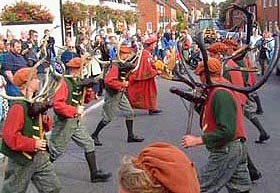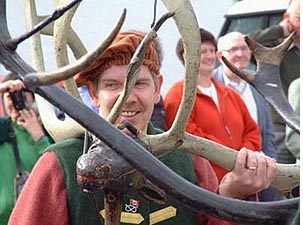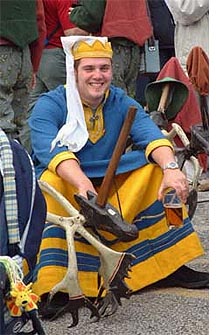The Abbots Bromley Horn Dance
by John Ravenscroft
They say we Brits can be a little eccentric, and when it comes to some of our more peculiar folk customs it's a charge that's hard to deny. (As an eccentric Brit myself, I'm allowed to say things like that.)
 If you want to see British eccentricity at its best, imagine it's a pleasant day in early September. You're visiting Abbots Bromley, Staffordshire, having a quiet lunchtime drink in one of the five charming pubs to be found in the village. You hear strange noises outside. You hear bellowing, singing, music.
If you want to see British eccentricity at its best, imagine it's a pleasant day in early September. You're visiting Abbots Bromley, Staffordshire, having a quiet lunchtime drink in one of the five charming pubs to be found in the village. You hear strange noises outside. You hear bellowing, singing, music.
You step out to investigate -- and suddenly twelve figures in brightly-coloured costumes are bearing down on you. Six of them hold huge antlers to their heads. One of the others is a man dressed as a woman -- Maid Marion -- and there's also a Dancing Fool belting any onlooker who comes within range with what appears to be an inflated pig's bladder tied to a stick. Someone else is wearing an elaborate Hobby-Horse costume, and close behind him comes a fellow with a bow and arrow who looks like he means business. The music-makers are an accordion-player and a boy carrying a triangle.
Don't worry, you haven't suddenly stepped into the Twilight Zone -- you've just arrived on the day the Horn Dancers of Abbot's Bromley hold their annual procession.
An Ancient Ceremony
These twelve characters -- the six Antler Men, the Hobby Horse, the Fool, Maid Marion, the Archer and the two musicians -- have been dancing through Abbots Bromley and the surrounding area each year for quite some time now. Since 1226, in fact. It's remarkable that nearly 800 years later they're still going strong, and even more remarkable that in all that time the Horn Dance has been cancelled only once. That's if the locals are to be believed, of course. And it seems they had good reasons for letting their public down that year: apparently one of the dancers died, and the accordion-player fell ill.
They haven't always danced in September, though. The Horn Dance used to take place around the time of the winter solstice, possibly as a way of marking the return of the sun, but now the festival is held on the first Monday after the first Sunday after the 4th of September. In 2005, that will be Monday 12th. There's a theory that this change of date was introduced in order to coincide with the onset of the deer rutting season, and certainly some aspects of the dance call that spectacle to mind!
Reindeer Antlers
 The traditional antlers currently used in the ceremony are cumbersome and heavy -- the largest pair is over three feet wide and weighs twenty-five pounds -- and they're something of a curiosity themselves. Contrary to popular belief, they're not actually antlers from deer stags. In fact, they are reindeer horns, mounted on wooden deer-heads. Poles are attached to these deer-heads to make the whole assembly easier to carry. Like the dance itself they go back quite a way. Carbon dating has shown one set of antlers to be in the region of 900 years old.
The traditional antlers currently used in the ceremony are cumbersome and heavy -- the largest pair is over three feet wide and weighs twenty-five pounds -- and they're something of a curiosity themselves. Contrary to popular belief, they're not actually antlers from deer stags. In fact, they are reindeer horns, mounted on wooden deer-heads. Poles are attached to these deer-heads to make the whole assembly easier to carry. Like the dance itself they go back quite a way. Carbon dating has shown one set of antlers to be in the region of 900 years old.
When not in use the antlers are stored safely away in Abbots Bromley Church, which is where the Dancers go to collect them on Horn Dancing Day. They rise early, receive a 7.30 a.m. blessing from the Vicar, and then set off on their tour of the local area, performing dances at twelve locations in and around Abbots Bromley, and covering some 10 miles in all. (According to some sources it used to be 20 miles, but it seems the Dancers are not as tough as they once were!)
At each location the main musician plays traditional English folk tunes on his accordion. 'The Farmer's Boy' is a fairly recent favourite. In earlier times the tunes would have been different, and the instrument of choice would have been the fiddle. Earlier still, the music came from the pipe-and-tabor.
The Costumes
The six Dancers used to wear their own clothes which they decorated with a few ribbons and bits of coloured cloth, but at some point in the 1850s a group of local women decided this wasn't good enough so they designed a Horn Dance costume which included a cap, knee-breeches, knitted stockings, and a jerkin. A version of this costume is still worn today.
Dance, Dance, Wherever You May Be...
On their tour of the area the Horn Dancers visit many of the local houses and farms. If they fail to come and dance for you, it's supposed to bring bad luck, so their arrival is always greeted with relief. The Dance itself begins with the horn-bearers leading the way into the garden or the farmyard where they form a silent circle. The music begins and the leader suddenly breaks the circle, passing between the second and third of the Dancers. The rest follow him, then form two lines with three Dancers in each line, facing each other. They raise their antlers as if they are about to fight, then back away, advance, lock horns -- and all the time the triangle-boy keeps time on his triangle, and the Hobby-Horse snaps his jaws to the rhythm of the music.
Origins
 There are several theories concerning the roots of this peculiar festival. It may well have begun as a Winter Solstice ritual, but it has also been suggested that it was born when King Henry I (1100-1135 AD) granted hunting rights to the people of the area. The dance was supposed to have been created as a mark of gratitude.
There are several theories concerning the roots of this peculiar festival. It may well have begun as a Winter Solstice ritual, but it has also been suggested that it was born when King Henry I (1100-1135 AD) granted hunting rights to the people of the area. The dance was supposed to have been created as a mark of gratitude.
The hunting rights theory is suspect, however, because the Horn Dance shows signs of having had a much earlier, pre-Christian beginning when magic and fertility ceremonies were very much aspects of the lives of ordinary people. It's interesting to note that some of the figures to be seen in the world-famous cave paintings at Lascaux look very like the Abbots Bromley Horn Dancers. These figures are over 20,000 years old, so perhaps the true origins of the dance you can see today at Abbots Bromley are far more ancient than most people realize.
Modern Horn Dancers (and the people who come to see them perform) have rather more comforts on offer than the average cave-dweller. Each year on Horn Dance Day, Abbots Bromley puts on various attractions, including craft stalls, food stalls and exhibitions. And of course, the village pubs are open all day!
Related Articles:
- The Helston Furry Dance, by John Ravenscroft
- https://www.timetravel-britain.com/articles/history/helston.shtml
More Information:
We regret that we no longer have the resources to maintain up-to-date links and/or hours and pricing details for the various sites and attractions listed on this website. For more information about the location(s) listed above, please use your favorite search engine or visit Wikipedia.
John Ravenscroft is a teacher-turned-writer who lives in Lincolnshire, England. He spends much of his time struggling to write fiction and co-editing Cadenza Magazine. His short stories have won prizes in various literary competitions and been published in numerous magazines, and his work has also been broadcast on the BBC. In 2005 he is planning to write more nonfiction articles. Visit his website at http://www.johnravenscroft.co.uk.
Article © 2005 John Ravenscroft
Photos © Phil Pugh
| 